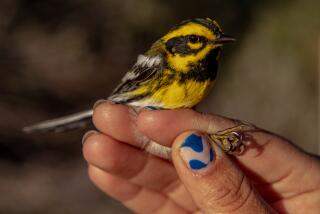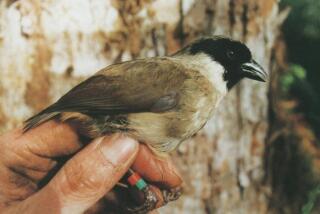Peter Berle, 69; led Audubon Society into wider environmental advocacy
- Share via
Peter A.A. Berle, a former president of the National Audubon Society who sought to broaden the environmental agenda of the venerable group and show that it was “no longer just for the birds,” died Nov. 1 in Pittsfield, Mass. He was 69.
Berle died of injuries from an accident in August, when the roof of a barn on his Stockbridge, Mass., farm collapsed as he was dismantling it, his family said.
A pioneering environmental lawyer and former New York state conservation commissioner, Berle (pronounced Burley) led the National Audubon Society from 1985 to 1995, when financial problems underscored a need for the group to reexamine its goals and public identity.
Convinced that Audubon should expand its base beyond bird watchers, he launched a reorganization that was at times painful, particularly when he attempted to remove the great egret as Audubon’s symbol and replace it with a flag.
The hue and cry from the rank and file subsided only when Berle acknowledged he had made a mistake, but he did not retreat from his larger objective: to help Audubon grow in its role as an advocate for the environment, as concerned with the habitat of humans as of birds.
“He had an early vision . . . for the sustainability and livability of cities,” said Glenn Olson, executive director of Audubon California, who knew Berle for 20 years. “Most of the areas Audubon was trying to protect were outside of cities. Peter brought it back into cities.”
An early champion of “green” architecture, Berle spearheaded the renovation of a century-old Manhattan brownstone into an eco-friendly showcase to house Audubon’s staff. Called Audubon House, it was ahead of its time when it opened in 1992, featuring nontoxic building materials, sensors that automatically turned off lights, desk-side recycling chutes and compost heaps on a rooftop garden.
To Berle and the 10,000 Audubon members who helped underwrite its $24-million cost, the building made a statement that Audubon had widened its scope.
“Today we can’t protect birds by building bird feeders and acquiring sanctuaries alone,” Berle said in 1992. “They are threatened by larger-scale dilemmas related to the way we use land and resources on a global basis.”
Described as a charismatic and vigorous man with a crushing handshake, Berle channeled resources into fighting global warming and lobbied for efforts to toughen the Endangered Species Act. He fought for the preservation of wetlands in California, promoted educational jaunts in the Florida Everglades for inner-city children and opposed oil drilling in the Arctic National Wildlife Refuge.
A fearless outdoorsman despite late-onset diabetes, he awed much younger colleagues with his physical prowess. In the late 1980s he undertook an arduous, 80-mile trek across mountains and tundra in the Arctic plain to gain a firsthand appreciation of the natural beauty at stake in the oil drilling. Much earlier, he had paddled 300 miles from Buffalo to Albany, N.Y., on the Erie Canal and collected water samples along the way.
“Nobody could keep up with him,” said John Flicker, who succeeded Berle as Audubon president. “Whether out hiking or bird-walking, he would start earlier, do it faster and do it longer than anybody, always with great enthusiasm.”
Berle learned to relish the outdoors on camping trips with his father, Adolf Berle Jr., a lawyer and economist who was a member of President Franklin D. Roosevelt’s original “brain trust.” He followed in his father’s footsteps to Harvard, where he majored in economics and earned his law degree. But he was also influenced by his mother, Beatrice Bishop Berle, a physician with a strong social conscience who ran a Harlem clinic for drug addicts. He spent his childhood in New York City, where he was born, and Great Barrington, Mass.
In 1960 Berle married Lila Sloane Wilde, whom he had known since childhood. She survives him along with two sons, Dolf of Pasadena and Robert of Charleston, S.C.; two daughters, Mary of Stockbridge, Mass., and Beatrice of Hoosick, N.Y.; a sister, Beatrice Meyerson of Washington, D.C.; and 13 grandchildren.
During the Vietnam War, Berle served in the Air Force as an intelligence officer and parachutist. Afterward he joined the law firm of Paul, Weiss, Rifkind and Garrison, where he and another junior lawyer drew the unenviable assignment of litigating against Consolidated Edison, which wanted to erect a pumping storage facility on a scenic mountain overlooking the Hudson River Gorge. Their precedent-setting victory forced the utility to ameliorate any environmental damage.
In 1971, not long after winning that case, he founded Berle, Butzel & Kass, one of the country’s first environmental law firms, where he waged a successful suit against Union Carbide Corp. for fouling underground water on Long Island with pesticides. As a member of the New York state Legislature, he played an integral role in the expansion of Adirondack Park.
From 1976 to 1979, he served under Gov. Hugh Carey as state commissioner of environmental conservation and helped set in motion the cleanup of the Love Canal toxic waste dump at Niagara Falls.
He became Audubon’s president in the middle of the Reagan era, a critical time for the environmental movement, when a leveling off of support was causing many mainstream conservation groups to rethink strategy. Audubon was struggling to wipe out a $1-million deficit.
Berle believed that Audubon’s future depended on its ability to expand its appeal beyond bird enthusiasts. According to Occidental College environmental historian Robert Gottlieb in his book “Forcing the Spring,” Berle worried that Audubon “had an image problem, a ‘bird watchers’ reputation that it had never fully shaken off.”
His fears were confirmed by outside consultants, who found that the society was seen as “old-fashioned and exclusive” with a narrow “bird-oriented” agenda. The consultants said Greenpeace, the radical environmentalist group that made headlines by sailing into nuclear test zones to protest the destruction of wildlife, got much higher ratings. It also had 2 million members worldwide compared with Audubon’s 500,000, and they were younger than the average Audubon loyalist.
Greenpeace, however, was not Berle’s model. “He wasn’t a bomb thrower,” said Donal C. O’Brien Jr., who was Audubon chairman during much of Berle’s tenure. But neither was Berle interested in saving Audubon’s feathered friends as an end in itself. “He was much more interested in the root causes of environmental problems,” O’Brien said. “He wasn’t as worried about the canvasback duck as about acid rain.”
A shake-up began in 1991. One remedy Berle backed was an overhaul of Audubon magazine from a somewhat musty, though highly regarded, nature journal to one that was more politically attuned.
Then Berle fixed his sights on the egret, which had stood for decades as a symbol of the greatest achievement in Audubon’s early history: a campaign to stop the slaughter of birds for their plumage. Different versions of the egret were used by local chapters, a bad practice for an organization seeking a more corporate character but not as problematic as the blatant birdness of the old logo.
So Berle banished the egret and hoisted the generic blue flag.
“The most unfortunate thing,” recalled Geoff LeBaron, who joined Audubon two years after Berle and now directs its annual Christmas bird count, “was that we didn’t understand that when the blue flag was Xeroxed it turned into a black flag” -- which reminded some critics of a certain brand of roach killer. Some of Berle’s public comments ( “We like birds. We just don’t think birds are the end of it,” he told the Washington Post at one point) contributed to fears that Audubon was being blown off course.
A grass-roots rebellion bloomed. Local chapters refused to use the flag on their stationery and sent it back to Audubon headquarters, along with other items bearing the offensive logo. According to one account, Audubon coffee mugs with the flag imprint arrived at the society’s offices in shards.
After months of turmoil, Berle reconsidered. “We hauled down the flag,” he told The Times in 1992, “and fed it to the egret.”
Although never gung-ho on birding, Berle had demonstrated his allegiance to Audubon’s heritage in his first year as president, when a South Carolina member complained about a marching song sung by female Marine recruits at Parris Island: I saw a bird with a yellow bill Sitting on my windowsill I coaxed him in with a piece of bread And then I crushed his little head.
Referring to his own military service, Berle wrote a letter to the Marine commandant, arguing that “advocacy of unsportsmanlike hunting techniques was not necessary to instill pride or toughness in troops.”
The song was banned.
--
More to Read
Sign up for Essential California
The most important California stories and recommendations in your inbox every morning.
You may occasionally receive promotional content from the Los Angeles Times.














